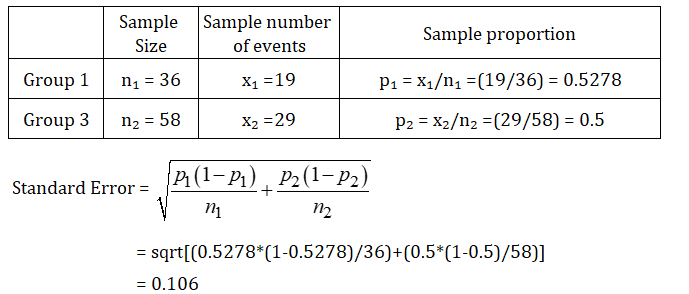A study published in the the journal Public Library of Science took 134 people, who were at risk of a stroke, and divided them randomly into three groups. Group one had 36 people and they participated in a stress management program. Group two had 40 people and they took part in an exercise program, and the remaining people were in group three. People in group three were just monitored by their doctor. After three years the number in each group who had a stroke or a related condition were recorded. The results are as follows: group one had 19 stroke/related conditions; group two had 17 stroke/related conditions; and group three had 29 stroke/related conditions. Let Pi be the population proportion of people at risk of a stroke participating in a stress management program having a stroke/related condition. Let p2 be the population proportion of people at risk of a stroke taking part in an exercise program having a stroke/related condition. Let P3 be the population proportion of people at risk of a stroke, who are just being monitored by a doctor having a stroke/related condition. Find the 95% confidence interval for §1 – Pzand give the lower bound. Give your answer to 3 decimal places.
A study published in the the journal Public Library of Science took 134 people, who were at risk of a stroke, and divided them randomly into three groups. Group one had 36 people and they participated in a stress management program. Group two had 40 people and they took part in an exercise program, and the remaining people were in group three. People in group three were just monitored by their doctor. After three years the number in each group who had a stroke or a related condition were recorded. The results are as follows: group one had 19 stroke/related conditions; group two had 17 stroke/related conditions; and group three had 29 stroke/related conditions. Let Pi be the population proportion of people at risk of a stroke participating in a stress management program having a stroke/related condition. Let p2 be the population proportion of people at risk of a stroke taking part in an exercise program having a stroke/related condition. Let P3 be the population proportion of people at risk of a stroke, who are just being monitored by a doctor having a stroke/related condition. Find the 95% confidence interval for §1 – Pzand give the lower bound. Give your answer to 3 decimal places.
MATLAB: An Introduction with Applications
6th Edition
ISBN:9781119256830
Author:Amos Gilat
Publisher:Amos Gilat
Chapter1: Starting With Matlab
Section: Chapter Questions
Problem 1P
Related questions
Question

Transcribed Image Text:A study published in the the journal Public Library of Science took 134 people, who were at risk of a stroke, and divided them randomly into three groups.
Group one had 36 people and they participated in a stress management program. Group two had 40 people and they took part in an exercise program,
and the remaining people were in group three. People in group three were just monitored by their doctor. After three years the number in each group who
had a stroke or a related condition were recorded. The results are as follows: group one had 19 stroke/related conditions; group two had 17 stroke/related
conditions; and group three had 29 stroke/related conditions.
Let pi be the population proportion of people at risk of a stroke participating in a stress management program having a stroke/related condition. Let p2 be
the population proportion of people at risk of a stroke taking part in an exercise program having a stroke/related condition. Let p3 be the population
proportion of people at risk of a stroke, who are just being monitored by a doctor having a stroke/related condition.
Find the 95% confidence interval for p1 - Pzand give the lower bound. Give your answer to 3 decimal places.
Expert Solution
Step 1

Step by step
Solved in 2 steps with 2 images

Recommended textbooks for you

MATLAB: An Introduction with Applications
Statistics
ISBN:
9781119256830
Author:
Amos Gilat
Publisher:
John Wiley & Sons Inc

Probability and Statistics for Engineering and th…
Statistics
ISBN:
9781305251809
Author:
Jay L. Devore
Publisher:
Cengage Learning

Statistics for The Behavioral Sciences (MindTap C…
Statistics
ISBN:
9781305504912
Author:
Frederick J Gravetter, Larry B. Wallnau
Publisher:
Cengage Learning

MATLAB: An Introduction with Applications
Statistics
ISBN:
9781119256830
Author:
Amos Gilat
Publisher:
John Wiley & Sons Inc

Probability and Statistics for Engineering and th…
Statistics
ISBN:
9781305251809
Author:
Jay L. Devore
Publisher:
Cengage Learning

Statistics for The Behavioral Sciences (MindTap C…
Statistics
ISBN:
9781305504912
Author:
Frederick J Gravetter, Larry B. Wallnau
Publisher:
Cengage Learning

Elementary Statistics: Picturing the World (7th E…
Statistics
ISBN:
9780134683416
Author:
Ron Larson, Betsy Farber
Publisher:
PEARSON

The Basic Practice of Statistics
Statistics
ISBN:
9781319042578
Author:
David S. Moore, William I. Notz, Michael A. Fligner
Publisher:
W. H. Freeman

Introduction to the Practice of Statistics
Statistics
ISBN:
9781319013387
Author:
David S. Moore, George P. McCabe, Bruce A. Craig
Publisher:
W. H. Freeman